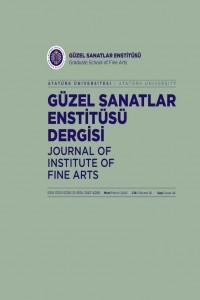Duruş Noktası: Fotoğrafta Karar Anı ve Yorum
Başarılı fotoğrafın gerekçesi olarak kabul edilen doğru “karar anı” (H. Cartier Bresson), aslında sadece doğru zamanla değil, konumla da ilgilidir. Bir başka deyişle duruş yerinin yanı sıra bakış hattı ve açısıyla da bütünleşmediği sürece, “karar anı” belirleyici olmaktan çıkar. Öte yandan kalıcı olmaya aday her fotoğrafa bu koşulları aşan bir başka şey daha eşlik eder: talih etmeni. Talih, fotoğrafın hammaddesi olan ışığın zaman ile gireceği iş birliğinin gizemli konuğudur. Bu çalışma “duruş noktası” ile kesişen “karar anı” kavramını, farklı zamanlarda ve yerlerde çekilmiş iki fotoğrafı yorumlayarak ele almaktadır. Bu araştırma farlı örnekler üzerinden bir karşılaştırma yaparak bakış hattının fotoğrafın anlamını ve dolayısıyla yorumu nasıl etkilediğini açıklamaktır.
Anahtar Kelimeler:
Duruş Noktası, Karar Anı, Dipyüzey, Perspektif, Fotoğraf
The Standpoint: Decisive Moment and Interpretation in Photography
The right “decisive moment” (H. Cartier-Bresson), which is accepted as the justification for successful photography, is not only about the right time but also the location. In other words, as long as it does not integrate with the point of view as well as the point of view, the “decisive moment” ceases to be decisive. On the other hand, another thing that exceeds these conditions accompanies every photograph that is likely to be permanent: the factor of luck. Fortune is the mysterious guest of the collaboration that light, the raw material of photography, will enter with time. This study discusses the concept of “decisive moment” that intersects with “standpoint” by interpreting two photographs taken at different times and places. This research aims to explain how the line of sight affects the meaning of the photograph and therefore the interpretation by making a comparison through different examples.
Keywords:
Standpoint, Decisive Moment, Bottom Surface, Perspective, Photograph,
___
- Bonitzer, P. (2006). Kör alan ve dekadrajlar. İ. Yaşar (Çev.). Metis Yayınları.
- Capa, R. (1943). Agrigento harabeleri arasında yaşlı kadın [Fotoğraf]. Collection of the Hungarian National Museum, International Center of Photography, Magnum, Hungary. https://www.arte.it/foto/la-liberazione-di-robert-capa-617/5
- Capa, R. (1943). Savaş insanlık dışıdır [Fotoğraf]. Collection of the Hungarian National Museum, International Center of Photography, Magnum, Hungary. https://tr.pinterest.com/pin/257690409914486103/
- Capa, R. (2020). Hafif flu. A. Altuntaş (Çev.). Espas Kuram Sanat Yayınları.
- Cartier Bresson, H. (2006). Karar anı. İ. Maga (Çev.). YGS Yayınları.
- Duane, M. (1976). Real dreams: Photostories, Thames & Hudson.
- Flusser, V. (2020). Bir fotoğraf felsefesine doğru. A. Yılmaz (Çev.). Espas Yayınları.
- Kemp, W. (1978). Foto-essays. Schirmer/Mosel.
- Nietzsche, F. (1966). Seçilmiş düşünceler. S. Tiryakioğlu (Çev.). Varlık Yayınları.
- Reuters Photographer. (2004). Bağdat’ta patlama [Fotoğraf]. https://www.alamy.com/an-iraqi-man-stands-near-the-collapsed-ceiling-of-his-house-following-an-overnight-blast-in-western-baghdad-december-29-2004-a-powerful-blast-destroyed-a-house-in-western-baghdad-during-an-overnight-police-raid-flattening-several-nearby-buildings-and-killing-at-least-28-people-including-seven-policemen-police-said-on-wednesday-reutersfaleh-kheiber-hhabp-image380920845.html
- Satkın, M. B. (2020). Köprüden bakış. Mustafa Bilge Satkın kişisel arşivi.
- Szarkowski, J. (2002). William Eggleston’s guide. The Museum of Modern Art.
- ISSN: 1300-9206
- Yayın Aralığı: Aylık
- Yayıncı: Atatürk Üniversitesi
Sayıdaki Diğer Makaleler
Sahne Tasarımının Gelişim Süreci İçerisinde Teknik Ve Teknolojinin Önemi
Geçirgenlik Kavramının Seramik Formlara Yansıması
Sanal Gerçekliğin Reklam Stratejilerinde Kullanılmasına Yönelik Bir Değerlendirme
Aylan Kurdi’den Sonra: Sanatta Göçün Kaydı
Grafik Tasarımı Bölümü Öğrenme Çıktılarının 21. Yüzyıl Becerileri Temelinde İncelenmesi
Aytaç ÖZMUTLU, Emel BAYRAK ÖZMUTLU
Üç Aşk Konulu Mesneviden Minyatürler ve Feraye Türküsü Minyatürü
